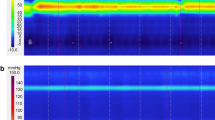Abstract
In this study five volunteers with special training in anal sphincter exercise (Scandinavian Yoga School) managed voluntarily to reduce anal pressure. The mean reduction of anal pressure was 20 mm Hg. In one of the subjects, this was shown by manometry during low spinal anesthesia and electromyography to be caused by relaxation of the external anal sphincter.
Similar content being viewed by others
References
Duthie HL, Watts JM. Contribution of the external anal sphincter to the pressure zone in the anal canal. Gut 1965;6:64–8.
Frenckner B, von Euler C. Influence of pudendal block on the function of the anal sphincters. Gut 1975;16:482–9.
Denny-Brown D, Robertson G. An investigation of the nervous control of defecation. Brain 1935;58:256–310.
Kerremans R. Morphological and physiological aspects of anal continence and defecation. Dissertation 1969; Arscia, Brussels.
Schuster MM, Hendrix TR, Mendelhoff AJ. The internal anal sphincter response: manometric studies on its normal physiology, neural pathways and alteration in bowel disorders. J Clin Invest 1963;42:196–207.
Porter NH. A physiological study of the pelvic, floor in rectal prolapse. Ann R Coll Surg Engl 1962;31:379–404.
Gaston EA. The physiology of fecal continence. Surg Gynecol Obstet 1948;87:2280–90.
Holmström B, Broden G, Dolk A, Frenckner B. Increased anal resting pressure following the Ripstein operation: a contribution to continence? Dis Colon Rectum 1986;29:485–7.
Neill ME, Parks AG, Swash M. Physiological studies of the anal sphincter musculature in fecal incontinence and rectal prolapse. Br J Surg 1981;68:531–6.
Cerulli MA, Mikoomanesh P, Schuster MM. Progress in biofeedback conditioning for fecal incontinence. Gastroenterology 1979;76:742–6.
Wasserman IF. Puborectalis syndrome (rectal stenosis due to anorectal spasm). Dis Colon Rectum 1964;7:87–98.
Rutter KR, Riddell RH. Solitary ulcer syndrome of the rectum. Clin Gastroenterol 1975;4:505–30.
Keighley MR, Shouler P. Outlet syndrome: is there a surgical option? J R Soc Med 1984;77:559–63.
Barnes PR, Hawley PR, Preston DM, Lennard-Jones JE. Experience of posterior division of the puborectalis muscle in the management of chronic constipation. Br J Surg 1985;72:475–7.
Bleijenberg G, Kuijpers HC. Treatment of the spastic floor syndrome with biofeedback. Dis Colon Rectum 1987;30:108–11.
Author information
Authors and Affiliations
Additional information
Read at the meeting of the International Society of University Colon and Rectal Surgeons, Dallas, Texas, May 4 to 8, 1986.
This investigation was supported by a grant from Kjell and Märta Beijer Foundation.
About this article
Cite this article
Brodén, G., Dolk, A., Frostell, C. et al. Voluntary relaxation of the external anal sphincter. Dis Colon Rectum 32, 376–378 (1989). https://doi.org/10.1007/BF02563687
Issue Date:
DOI: https://doi.org/10.1007/BF02563687




